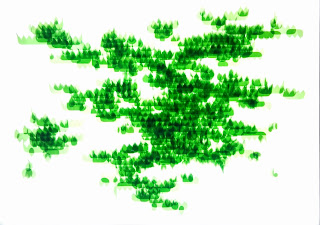One often hears that “contemporary art is open to interpretation”. Meaning-making in visual art tends to be overwhelmingly personal, and reading an artwork relies on knowledge about art history, socio-political environment, cultural tropes, etc. Typically overlooked are the emotional and thinking states of the viewer, when one visits an exhibition space. In the case of “Extending Ideas”– the Goethe-Institut sponsored follow-up to “Thinking Drawing” – I alighted the café’s staircase after learning about the Zika virus earlier that morning. Despite having seen a number of exhibits by Elias Yamani Ismail and Veronika Neukirch in shows last year, the former’s critical take on standards appear less potent, while fruits depicted by the latter (silicon-plaster, or otherwise) seem more forbidden than before.
 |
| Astrid Köppe - Baran Light Box I (2015) |
Vacuum-packed wooden carvings by Eddie Choo Wen Yi recall a quarantined environment, or imported Chinese New Year delicacies. Incising hand traces onto sculptures of everyday objects, the artist’s intention to present warmth now more resemble a memento mori. ‘Baran Light Box I’ by Astrid Köppe projects a wonderful play with a Japanese material and its form, but her pink styrofoam clusters only remind of death-seeking viruses. Elias – who wrote a jejune essay about bricolage in art– presents the most visually attractive work made from scouring pads and PVC connectors. Alas, its title ‘Osedax’ refers to a deep sea bone-eating worm. No thanks to the timing of the visit, my interpretations for these artworks had other morbid ideas, beyond extended ones.
 |
| Elias Yamani Ismail - Osedax (2016) |